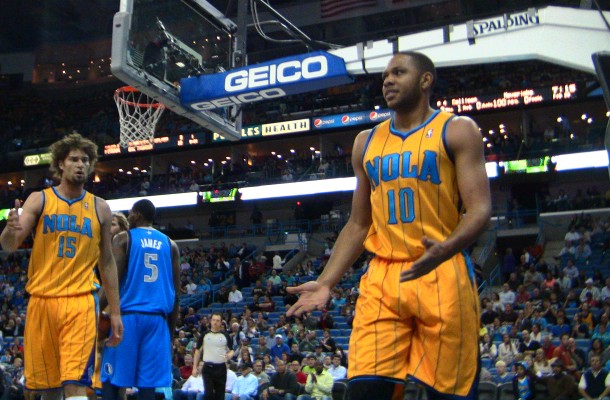« Anthony Davis Tips the Hornets past the Celtics.
Untying Winning and Losing »
Eric Gordon: Attention, Please

I’m confused too, Eric^^
I began writing this article before the Boston game, not realizing just how appropriate the game’s finish would make this post. On the final Hornets play, Eric Gordon drove to the basket and missed his shot, but Anthony Davis was there to tip it in and seal the victory. While I am in favor of hoarding ping pong balls like dragons hoard gold, it was nice to see the Hornets grab a win against a solid team.
This week’s post about Eric Gordon will focus on something specific, rather than giving a long, general overview of his recent games. He was aggressive against Washington early, but he was not a factor in the second half. He disappeared entirely versus Minnesota, and per usual, he had to sit out the second game of a back to back (vs Golden State). Finally, he became more aggressive against Boston after a quiet start, and although he wasn’t particularly efficient from the field, he did manage to earn 8 free throws. Perhaps more importantly, he had two nice drive and kicks to Ryan Anderson at the end of the game, along with the drive that led to the Davis tip-in.
There is a term frequently used on the In the NO Podcasts: “Kobe Assists.” This occurs when someone draws extra defenders, but shoots anyway. He misses the shot, but because of the attention he drew, a teammate grabbed an easy rebound and scored. This is fairly common, and it is one of the reasons that players who can draw extra defenders are so valuable, especially if they can get to the rim. Shot-blockers usually come over, which often frees the shooter’s teammates for easy rebounds and points.
I decided to chart every single Eric Gordon missed field goal attempt of the year (using Synergy video), and I divided each of his misses into two categories: ones derived from driving to the basket, and ones resulting from jumpers. Driving to the basket entailed any movement towards the hoop, not just shots at the rim. Then, I marked down the result of each miss. Any result in which the Hornets maintained possession of the ball is labeled under the “Retained Possession” category, whether it was through a Hornets putback attempt, a botched rebound by the other team, etc. Conversely, any instance in which Gordon’s missed shot resulted in the other team gaining possession was marked in the “Lost Possession” category. Rocket science, I know.
The results
| Shot Miss Type | Number of Occurences | Retained Possession | Lost Possession | Retained Possession Rate |
|---|---|---|---|---|
| On Drive | 101 | 47 | 54 | 47% |
| Jumper | 137 | 40 | 97 | 29% |
What they mean
When I began doing the video research for the post, I was under the impression that there would be a material difference in the Hornets’ retained possession rates, but I did not expect the difference to be so drastic. The Hornets managed to retain possession at a substantially higher rate when he missed a shot after driving, as they maintained possession nearly half of the time. When he missed jumpers, they only kept possession just under one-third of the time.
*There were about 7 shot misses that I did not factor in. 6 of them were buzzer-beaters, and as time had run out when each shot reached the basket, there was no opportunity for a rebound. Also, there was a problem with the video on one of his shots.
Other considerations
- As stated above, the Hornets have a better chance of keeping possession when Gordon misses shots while moving towards the basket.
- Gordon’s highest success rate occurs at the rim
- Gordon draws the majority of his free throws while driving to the basket
- Driving to the basket helps teammates get open shots
Conclusion
So Gordon is most successful scoring when he drives to the basket, and even when he misses, the Hornets have a higher chance of keeping the ball? Sounds like he might want to try it a bit more often. I’m not trying to say that Gordon should never take jumpers, because that’s unrealistic. Sometimes, jumpers are all that is available. Opposing defenses often bait him into jump shots by sagging and giving him just enough room to pull up for a shot. When Gordon has his feet set, some of these are decent shots. However, there are plenty of times when Gordon forces step-back jumpers, and not only are many of them missing, opposing teams are grabbing the rebounds and attacking the Hornets for easy transition points.





Pingback: Eric Gordon: Attention, Please – Hornets247 | PR NEWs Daily
Pingback: From Out of Nowhere | New Orleans Hornets | Hornets247.com
Pingback: Eric Gordon: Sifting Through Fool’s Gold | New Orleans Hornets | Hornets247.com
Pingback: Repo Rate: Starting Backcourt | New Orleans Hornets | Hornets247.com